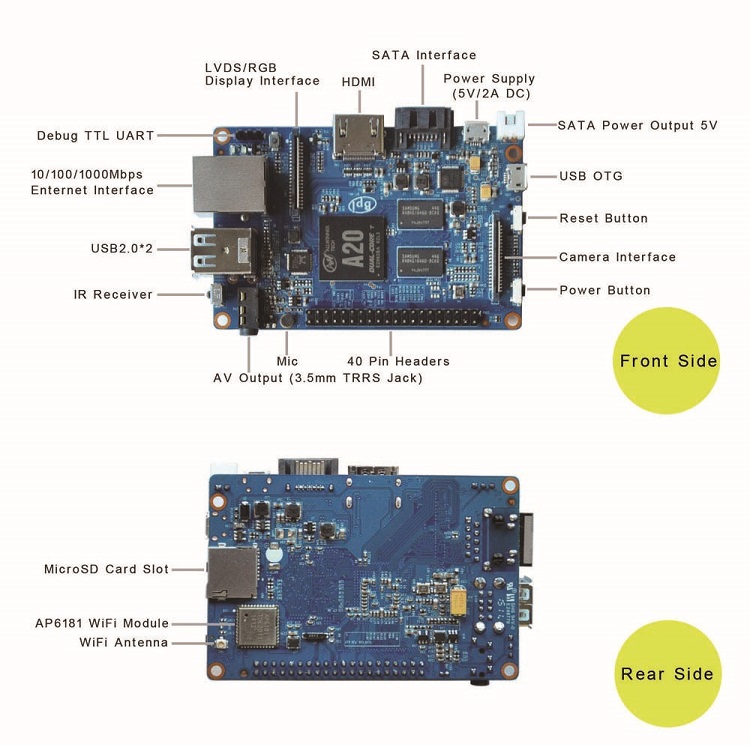Banana Pi
Banana Pi is an open source hardware project lead by GuangDong BiPai technology co., LTD. It focuses on the open source hardware development board of ARM and MCU series, provides open software and hardware platform, and creates the basic technology development platform. Full series open source hardware products, complete integration of voice, data, video system platform. Developers can flexibly build various application platforms on the open source hardware foundation platform. It can be applied in the Internet of things, AI artificial intelligence, industrial Internet control, STEAM education and other aspects.
The Banana Pi boards are inspired by the Raspberry Pi project, and some of the models have an equivalent Raspberry version which is hardware compatible and exactly the same size so that they can work as drop-in replacements for projects that are designed around Raspberry Pi boards. The Banana Pi boards are more powerful than the Raspberry boards, and have more features, for example many Banana Pis such as the Banana Pi M1+ come with a SATA port. This means they can run off a proper hard drive rather than an SD card which has been the cause of a lot of reliability trouble with these single-board computers.
Note that the concept of a "drop-in" replacement only goes so far in the world of single-board computers, because OS images need to be built specifically for each board. The Debian-based Armbian project is very good for this because it's been designed to be able to quickly support new boards and OS releases as they come out. They currently support about fifty different boards including the whole Banana Pi series.
Contents
Banana Pi M1+ board layout
Armbian and headless installation
Armbian is a great source of up to date OS images with versions available for the Banana Pi series. But one problem with the default minimal server images is that they are not truly headless, you need to set a root password on the first run before SSH logins will work. This is a big problem for us because we don't have keyboards and monitors lying around - occasionally we have TV available, but definitely not a keyboard since we only use laptops, phones and tablets. This is constantly being raised with the developers but they won't budge on it because their perspective is that providing a fully headless version would lead to their OS being used in malicious bot-nets.
However, we do have access to the full OS file-structure, so we can use qemu and chroot to open a shell inside the SD card OS and then set the root password before putting the card into the Pi (see this Debian wiki page and final comments in this Armbian forum post for more detail).
Here's how we can do it where XX is the path to your mounted SD card or Armbian image file. You could also do any other basic setup you may wish to do here such as create a non-root user, change over to key-based logins, set up your networking details such as wifi access (in /boot/armbian_first_run.txt based on /boot/armbian_first_run.txt.template) etc.
apt install qemu-user-static
cp /usr/bin/qemu-arm-static XX/usr/bin
chroot XX
passwd root
exit
syncYou can then scan for you device on the subnet as usual and ssh into it with the updated details you provided.
nmap -sP 192.168.0.0/24Getting wifi to work on the M1+
Armbian for some reason thinks that the M1+ is an M1 which you can see with the following command. This means that the system does not register any evidence of a wifi chip and there will be no wlan0 interface in ifconfig and nothing will show in iwconfig.
# cat /proc/device-tree/model
LeMaker Banana PiIf you get this result, then edit /boot/armbianEnv.txt and add the following line to the end of the file:
fdtfile=sun7i-a20-bananapi-m1-plus.dtbAfter rebooting, you should now see the following result from the command instead and you should now have a wlan0 network interface.
# cat /proc/device-tree/model
Banana Pi BPI-M1Useful commands
Monitor the power voltage:
while true ; do echo "$(awk '{printf ("%0.2f",$1/1000000); }' </sys/power/axp_pmu/ac/voltage)V"; sleep 1; done







